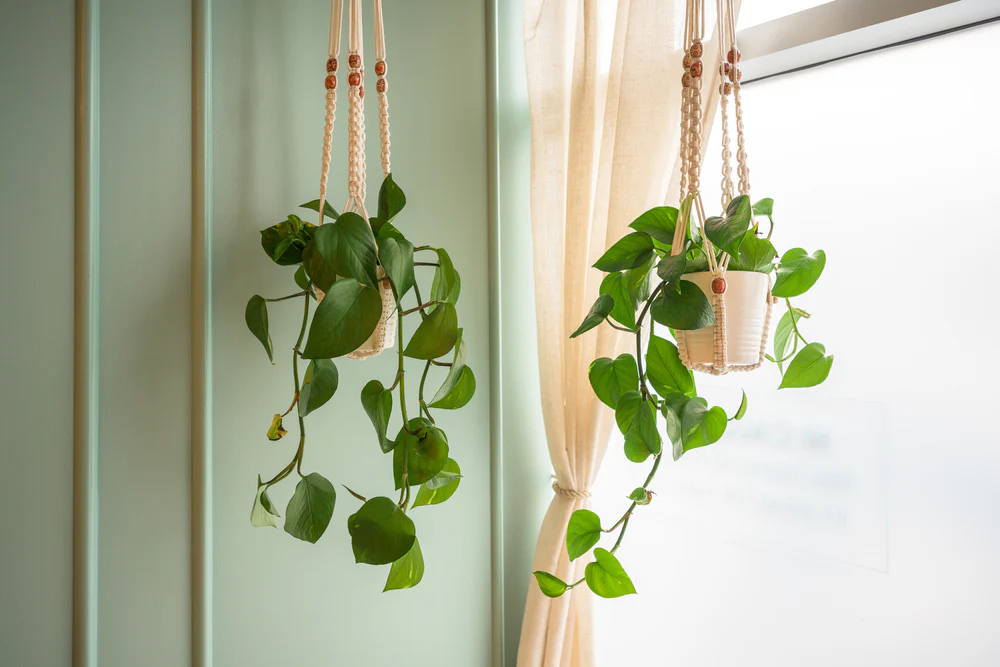
Hanging Plants Indoors: A Comprehensive Guide
Hanging plants are an increasingly popular choice for indoor gardening, offering a unique way to enhance your living space without taking up valuable floor space. This guide will explore the benefits of indoor hanging plants, the best types to consider, care tips, and answers to frequently asked questions.
Benefits of Hanging Plants
- Space Efficiency: Hanging plants utilize vertical space, making them ideal for small apartments or homes where floor space is limited.
- Aesthetic Appeal: They add a touch of greenery and can transform dull corners into vibrant focal points. The cascading nature of many hanging plants creates a beautiful visual effect.
- Improved Air Quality: Many indoor plants act as natural air purifiers, filtering toxins and improving overall indoor air quality. This can lead to a healthier living environment.
- Accessibility: Hanging plants can be placed out of reach of pets and children, making them a safer option for families.
- Variety: There is a wide range of plants suitable for hanging, allowing for diverse arrangements and combinations that can match any decor style.
Choosing the Right Hanging Plants
When selecting plants for your indoor hanging garden, consider the following factors:
- Light Requirements: Different plants have varying light needs, from low light to bright indirect sunlight. Choose plants that match the lighting conditions of your space.
- Maintenance Level: Some plants are more forgiving and require less care, making them ideal for beginners. Consider your lifestyle and how much time you can dedicate to plant care.
- Growth Habit: Look for plants with trailing or cascading growth habits, as these will look best in hanging arrangements.
Recommended Hanging Plants
Here’s a list of some popular indoor hanging plants:
| Plant Name | Light Requirements | Watering Needs | Notes |
|---|---|---|---|
| Pothos | Low to bright indirect | Once a week | Very forgiving; great for beginners. |
| Spider Plant | Low to bright indirect | Once a week | Produces “plantlets” for propagation. |
| Heartleaf Philodendron | Low to bright indirect | Once a week | Easy to care for and propagates easily. |
| String of Hearts | Bright indirect | Every 1-2 weeks | Unique heart-shaped leaves. |
| English Ivy | Bright indirect | Once a week | Can help purify air. |
| Boston Fern | Bright indirect | Keep soil moist | Prefers higher humidity. |
| Staghorn Fern | Bright indirect | Soak weekly | Unique appearance; can be mounted. |
Care Tips for Hanging Plants
- Watering: The frequency of watering will depend on the plant type and environmental conditions. Generally, check the top inch of soil; if it’s dry, it’s time to water.
- Fertilizing: Use a balanced, water-soluble fertilizer every 4-6 weeks during the growing season (spring and summer) to promote healthy growth.
- Pruning: Regularly prune your plants to encourage bushier growth and remove any dead or yellowing leaves.
- Pest Management: Keep an eye out for common pests like spider mites and aphids. Use insecticidal soap or neem oil if infestations occur.
- Repotting: As your plants grow, they may outgrow their pots. Repot them into a slightly larger container every couple of years.
Frequently Asked Questions (FAQ)
1. What plants are good to hang in windows?Plants that thrive in indirect sunlight are ideal for hanging in windows. Consider options like Spider Plants, Pothos, or String of Pearls, which tolerate varying light conditions.
2. How often should you water hanging plants?Watering frequency depends on the plant type and environmental conditions. Generally, check the soil moisture regularly and water when the top inch feels dry, which could range from once a week to every few days.
3. What is the best fertilizer for hanging plants?A balanced fertilizer with an NPK ratio of 10:10:10 is recommended. This supports healthy growth and foliage quality. Apply every 15 days during the growing season.
4. What hanging plants last the longest?Certain succulents and cacti, like Burro’s Tail and String of Bananas, tend to last longer in hanging baskets due to their resilience and water-storing capability.
5. Can I grow food in hanging planters?Yes, many herbs and small fruits like strawberries can be grown in hanging planters, provided they receive adequate sunlight and care.
Conclusion
Hanging plants are a fantastic way to bring life into your home while conserving space and enhancing air quality. With the right selection of plants and proper care, you can create a stunning indoor garden that thrives and beautifies your living environment.For more detailed information on the benefits and types of indoor plants, you can refer to the Wikipedia page on Indoor Plants.


